The Microsoft Surface Laptop 3 (15-Inch) Review: AMD Ryzen Surface Edition
by Brett Howse on October 21, 2019 9:00 AM EST- Posted in
- Laptops
- AMD
- Microsoft
- Surface
- Ryzen
- Surface Laptop
- Surface Laptop 3
Battery Life
Microsoft outfits all of the Surface Laptop 3 models with just a 46 Wh battery, which is actually slightly smaller than the one in the Surface Laptop 2, and all despite this 15-inch model being physically larger. Microsoft has also changed their battery testing methodology from a basic local video playback time, to a more realistic workload, so if you’re looking at the Microsoft spec pages, expect to see a lower runtime advertised as well.
The original Ryzen 2000 Raven Ridge platform had some serious power management issues, and this will be our first test of any Picasso based laptops, since AMD hasn’t had a lot of big design wins previous to this one for their second generation Ryzen APU.
Light Web

The 15-inch Surface Laptop 3 achieves just a touch under nine hours of runtime in our least-intensive battery test, with the display set to our standard of 200 nits brightness. While nine hours is a reasonable amount of time, it’s still well under the results from the smaller 13.5-inch Surface Laptop 2 we tested, which achieved almost 12 hours. That is a significant difference, of which some could likely be accounted by the larger display, which would inherently require more power to get to 200 nits, but it’s too big of a discrepancy to rest only on the display.
2016 Web
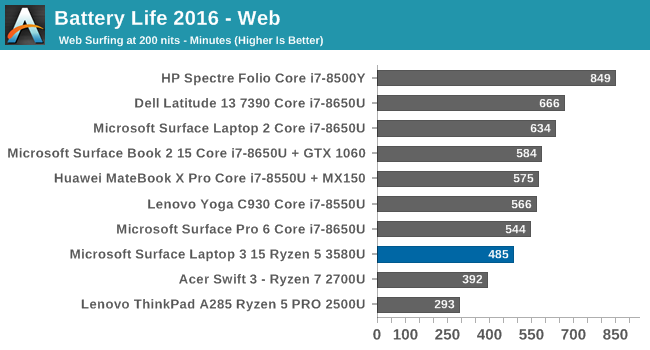
Our newer web test is much more CPU intensive, and a more realistic result than the older, lighter test. As expected, the results dropped further, to just over eight hours of usage, which is still a reasonable amount of time, but well under the 10.5 hours achieved by the Surface Laptop 2.
Movie Playback
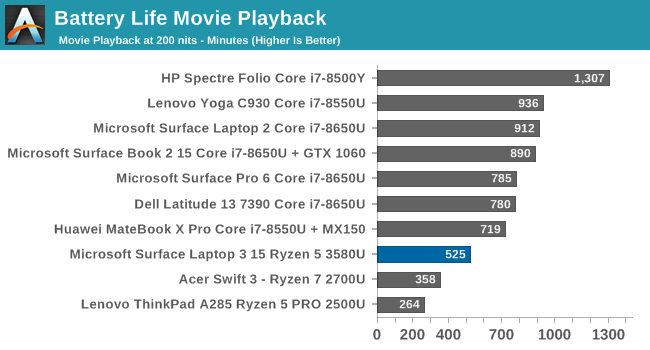
Video playback is one of Intel’s strengths, but it continues to be one of AMD’s weaknesses, with video playback time far shorter than the Intel offerings. Intel has put a lot of effort into offloading the video playback to fixed function hardware and turning the rest of the chip off, and while AMD certainly has hardware decode on their APU, it clearly can’t turn off the rest of the chip during playback, since the battery run time is somewhat less than our light web test.
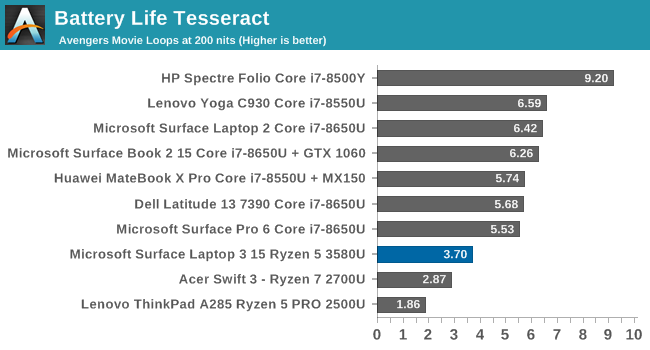
On the Tesseract score, the Surface Laptop 3 is still able to watch almost four entire sittings of The Avengers, which is a lot, but well under the 6.4 plays on the Surface Laptop 2.
Normalized Results
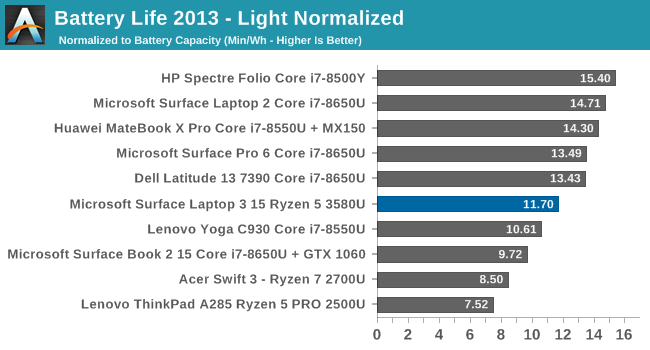
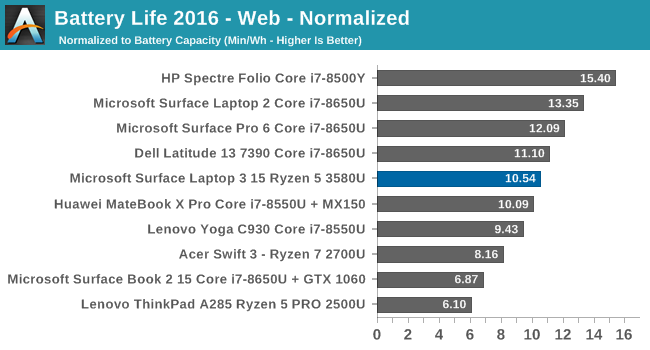
Removing the battery size from the runtimes lets us look at overall platform efficiency during the tests, and removes the insane runtime the Surface Book 2 provides thanks to its massive battery. Here the results are mixed. AMD has certainly made some tremendous strides in improving the abysmal platform power of the Ryzen APU from the original Raven Ridge to the current Picasso platform, with a much better showing in both the light test and 2016 Web results. Some of the discrepancy would come down to the display as well, since the larger 15-inch IGZO panel will need more power to light up to 200 nits than an equivalent 13.5-inch that we see in the Surface Laptop 2, but AMD definitely has more work to do in order to bring Ryzen's platform power down to what Intel has achieved.
The Acer Swift 3, which was the first Raven Ridge laptop we tested, drew 5.71 watts of power at idle with the display at 200 nits. That actually compares favorable with a Surface Book 2 15, which draws about the same – 5.53 Watts at idle with the display at 200 nits, but the main difference is the Surface Book 2’s display is the majority of the power draw thanks to its high resolution and 15-inch size. Removing display power from the devices results in the Acer Swift 3 drawing 4.55 watts at idle, and the Surface Book 2 drawing just 1.43 watts. The HP Spectre Folio, which features a Core i7 Y series processor, draws just 750 mW of power at idle.
The Surface Laptop 3 draws right around 5 Watts of power at idle with the display at 200 nits. That’s once again similar to the Surface Book 2 15, which draws 5.53 Watts. However, the Surface Laptop 3’s lower resolution display accounts for much less of the total platform draw. Removing the display from the equation results in the Surface Laptop 3 still drawing 2.35 Watts at idle. That’s significantly more than an Intel platform. So, while AMD has improved their battery draw tremendously, 2.35 Watts of idle power draw is still a lot and leads to the 15-inch Surface Laptop 3 delivering less battery life than the Surface Laptop 2, which was 8th generation Intel.
Charge Time
To make up for the less than amazing battery life of the Surface Laptop 3, Microsoft does include a stout 65-Watt charger which connects to the Surface Connect Port. All Surface power bricks also include an integrated USB-A output which is very handy when traveling if you need to charge your phone, although they may need to add USB-C soon.
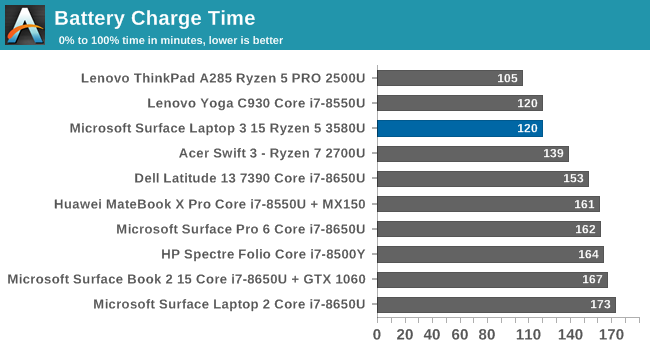
The Surface Laptop 3 charged very quickly. The smaller than average battery sized coupled with a larger than average adapter gave Microsoft lots of capacity to quickly get the Laptop 3 back up to a full charge.










91 Comments
View All Comments
evernessince - Tuesday, October 22, 2019 - link
You make it sound like last gen Intel mobile products are such a step back when in fact they are identical to current products on the market and Intel's "next-gen" products as well. The performance gains have piddling at best. 8 and 9th gen products for all intents are purposes are the same architecture and nm process. You also left out the fact that an R5 mid range processor is beating some of Intel's i7 high end processors in CPU performance. Battery life could be better but have you done the calculation of performance per mAH of the battery? Or are you just assuming with considering the size of the battery and the performance being afforded? How do Intel laptops with similar performance characteristics and battery size fare? Like any laptop, battery life is dependent on more then just the chip on the device.Your comment is misleading, intentional or otherwise.
0ldman79 - Sunday, December 15, 2019 - link
Nah, AMD's battery life still isn't up to par against Intel's 25th Skylake revision, not even the original release.AMD is kicking ass on the desktop but the mobile front is still a bit much. Intel has spent billions making laptops more efficient. They've done well. They got the laptop market under their thumb, even today, while they've effectively lost the performance desktop battle.
The_Assimilator - Monday, October 21, 2019 - link
Not sure why AMD had such a hard-on to get a CPU that is evidently not mobile-focused, into an extremely mobile form factor. No support for LPDDR4, no built-in WiFi, and an iGPU that isn't powerful enough to make any tangible difference to an Intel offering, just makes for a "why".Irata - Monday, October 21, 2019 - link
Oh, Ryzen's iGPU does offer a tangible real life difference if the reviewer choses to include the right benchmarks and also show's the Intel iGPU results for them.Tech Report's and Computer Base's Ryzen 2500u review do and they show that the tangible difference is 50 to over 100% better fps, greatly better frame times, i.e. the difference between a game being playable, or not.
TheinsanegamerN - Tuesday, October 22, 2019 - link
If you have to include “the right benchmarks” to make your APU look good, your product sucks, and you are engaging in the very behavior you accuse anandtech of. Hypocritical.evernessince - Tuesday, October 22, 2019 - link
Well that depends. The sample size is this review is rather small. Very small in fact. Adding more certainly wouldn't hurt. It's less about adding the right benchmarks then it is getting a more reliable dataset. If another review is showing data that more appropriately demonstrates the GPU's capability, that indicates that perhaps the test suite used here is not ideal.Irata - Thursday, October 24, 2019 - link
With "the right" I mean proper benchmarks.One of the advantages of having a better iGPU is that it allows you to do things that you cannot do with a weaker iGPU. Casual gaming, particularly e-sports titles come to mind. Same for any GPU accelerated software.
If you do not include any of those in a review (e.g. just compare them on the basis of surfing the web and watching a few videos), then you are hiding these advantages.
MS segmented their surface laptops into "business" (Intel) where the better battery life is an advantage when you are using it for email, powerpoint, Word, Excel but most likely not causal gaming or content creation.
For this you have have the AMD based consumer platform with its faster iGPU - have a look at the PC mark scores to see how it scores there. You can also check other reviews for Laptops with other Ryzen APU to see that they do offer a tangible advantage over Intel's iGPU when it comes to being able to still play a game or not.
That advantage is paid for with lower battery life in idle / low load situations (not necessarily true for higher load), so it really comes down to what is more important to you. I know that for my work laptop, I would value the extra battery life, for a personal one the ability to do a bit of casual gaming would be worth having a shorter battery life (which is still decent, we are not talking Bulldozer here).
So not hypocritical imho. Just pointing out that a review should include tests for what it was built for / is aimed at.
m53 - Wednesday, November 20, 2019 - link
All the benchmarks I have seen so far, the ice lake iGPU is equal or better than AMD APUs for same TDP. On the otehr hand the CPU is tangibly faster with much better battery life and connectivity (wifi6 built-in).Fulljack - Tuesday, October 22, 2019 - link
Intel doesn't have built-in wifi either. current offering actually still use smaller RF module, due to Intel CNVi. I don't get why Microsoft doesn't release AMD with latest ax chipset, because Intel AX200 does works on AMD system too.GreenReaper - Tuesday, October 22, 2019 - link
Surely it's because it costs more, and this is meant to be the more affordable option?